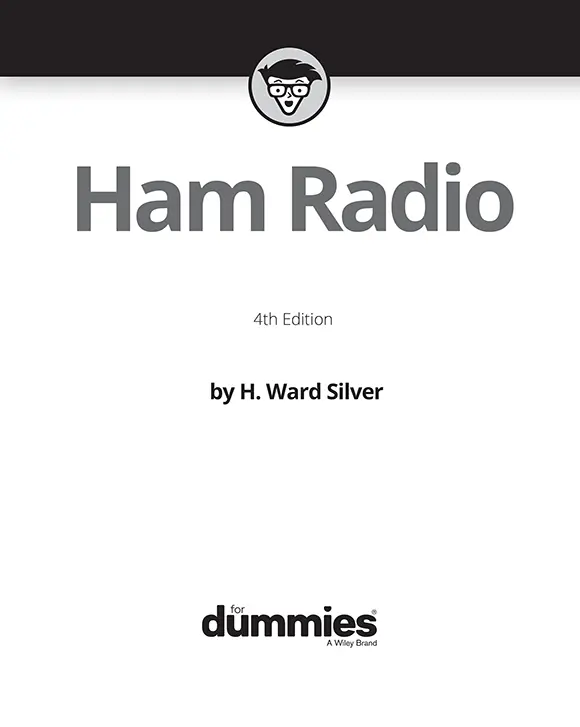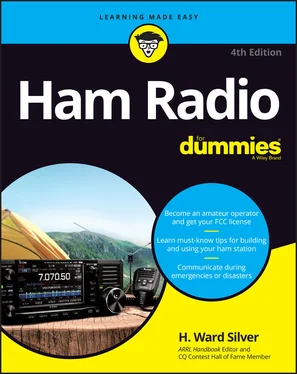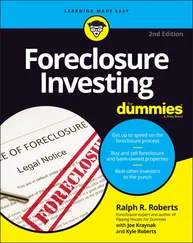
Ham Radio For Dummies®, 4th Edition
Published by: John Wiley & Sons, Inc.,111 River Street, Hoboken, NJ 07030-5774, www.wiley.com
Copyright © 2021 by John Wiley & Sons, Inc., Hoboken, New Jersey
Published simultaneously in Canada
No part of this publication may be reproduced, stored in a retrieval system or transmitted in any form or by any means, electronic, mechanical, photocopying, recording, scanning or otherwise, except as permitted under Sections 107 or 108 of the 1976 United States Copyright Act, without the prior written permission of the Publisher. Requests to the Publisher for permission should be addressed to the Permissions Department, John Wiley & Sons, Inc., 111 River Street, Hoboken, NJ 07030, (201) 748-6011, fax (201) 748-6008, or online at www.wiley.com/go/permissions .
Trademarks:Wiley, For Dummies, the Dummies Man logo, Dummies.com, Making Everything Easier, and related trade dress are trademarks or registered trademarks of John Wiley & Sons, Inc. and may not be used without written permission. All other trademarks are the property of their respective owners. John Wiley & Sons, Inc. is not associated with any product or vendor mentioned in this book.
LIMIT OF LIABILITY/DISCLAIMER OF WARRANTY: THE PUBLISHER AND THE AUTHOR MAKE NO REPRESENTATIONS OR WARRANTIES WITH RESPECT TO THE ACCURACY OR COMPLETENESS OF THE CONTENTS OF THIS WORK AND SPECIFICALLY DISCLAIM ALL WARRANTIES, INCLUDING WITHOUT LIMITATION WARRANTIES OF FITNESS FOR A PARTICULAR PURPOSE. NO WARRANTY MAY BE CREATED OR EXTENDED BY SALES OR PROMOTIONAL MATERIALS. THE ADVICE AND STRATEGIES CONTAINED HEREIN MAY NOT BE SUITABLE FOR EVERY SITUATION. THIS WORK IS SOLD WITH THE UNDERSTANDING THAT THE PUBLISHER IS NOT ENGAGED IN RENDERING LEGAL, ACCOUNTING, OR OTHER PROFESSIONAL SERVICES. IF PROFESSIONAL ASSISTANCE IS REQUIRED, THE SERVICES OF A COMPETENT PROFESSIONAL PERSON SHOULD BE SOUGHT. NEITHER THE PUBLISHER NOR THE AUTHOR SHALL BE LIABLE FOR DAMAGES ARISING HEREFROM. THE FACT THAT AN ORGANIZATION OR WEBSITE IS REFERRED TO IN THIS WORK AS A CITATION AND/OR A POTENTIAL SOURCE OF FURTHER INFORMATION DOES NOT MEAN THAT THE AUTHOR OR THE PUBLISHER ENDORSES THE INFORMATION THE ORGANIZATION OR WEBSITE MAY PROVIDE OR RECOMMENDATIONS IT MAY MAKE. FURTHER, READERS SHOULD BE AWARE THAT INTERNET WEBSITES LISTED IN THIS WORK MAY HAVE CHANGED OR DISAPPEARED BETWEEN WHEN THIS WORK WAS WRITTEN AND WHEN IT IS READ.
For general information on our other products and services, please contact our Customer Care Department within the U.S. at 877-762-2974, outside the U.S. at 317-572-3993, or fax 317-572-4002. For technical support, please visit https://hub.wiley.com/community/support/dummies .
Wiley publishes in a variety of print and electronic formats and by print-on-demand. Some material included with standard print versions of this book may not be included in e-books or in print-on-demand. If this book refers to media such as a CD or DVD that is not included in the version you purchased, you may download this material at http://booksupport.wiley.com . For more information about Wiley products, visit www.wiley.com .
Library of Congress Control Number: 2021934046
ISBN 978-1-119-69560-8 (pbk); ISBN 978-1-119-69576-9 (ebk); ISBN 978-1-119-69561-5 (ebk)
Ham Radio For Dummies®
To view this book's Cheat Sheet, simply go to www.dummies.comand search for “Ham Radio For Dummies 4e Cheat Sheet” in the Search box.
Table of Contents
1 Cover
2 Title Page
3 Copyright
4 Introduction About This Book My Assumptions about You Icons Used in This Book Beyond the Book Where to Go from Here
5 Part 1: Getting Started with Ham Radio Chapter 1: Getting Acquainted with Ham Radio Exploring Ham Radio around the World Tuning into Ham Radio Radiosport — Competing with Ham Radio Communicating through Ham Radio Contacts Citizen Science and HamSCI Chapter 2: Getting a Handle on Ham Radio Technology Getting to Know Basic Ham Radio Gear Building a Basic Ham Radio Station Communication Technologies Understanding the Fundamentals of Radio Waves Dealing with Mother Nature Chapter 3: Finding Other Hams: Your Support Group Finding and Being a Mentor Interacting in Online Communities Joining Radio Clubs Exploring the ARRL Taking Part in Specialty Groups Attending Hamfests and Conventions
6 Part 2: Wading through the Licensing Process Chapter 4: Understanding the Licensing System Getting Acquainted with the Amateur Service Learning about Types of Licenses Getting Licensed Receiving Your New Call Sign Chapter 5: Preparing for Your License Exam Getting a Grip on the Technician Exam Finding Study Resources Locating Your Mentor Chapter 6: Taking the Exam Types of Exams Finding an Exam Session Registering with the Universal Licensing System (ULS) Getting to Exam Day Chapter 7: Obtaining Your License and Call Sign Completing Your Licensing Paperwork Finding Your Call Sign Picking Your Own Call Sign Maintaining Your License
7 Part 3: Hamming It Up Chapter 8: Receiving Signals Learning by Listening Using Your Receiver Receiving Signals Chapter 9: Basic Operating Understanding Contacts (QSOs) Casual Conversation — Ragchewing Making Repeater and Simplex Contacts Digital Voice Systems Casual Operating on HF Chapter 10: Public Service Operating Joining a Public Service Group Preparing for Emergencies and Disasters Operating in Emergencies and Disasters Providing Public Service Participating in Nets Digital Message Networks Chapter 11: Operating Specialties Getting Digital DXing — Chasing Distant Stations Taking Part in Radio Contests Chasing Awards Mastering Morse Code (CW) QRP (Low Power) and Portable Operating Operating via Satellites Seeing Things: Image Communication
8 Part 4: Building and Operating a Station That Works Chapter 12: Getting on the Air What Is a Station? Planning Your Station Choosing a Radio Choosing an Antenna Supporting Your Antenna Station Accessories Remote Control Stations Upgrading Your Station Chapter 13: Organizing a Home Station Designing Your Station Building in RF and Electrical Safety Grounding and Bonding Chapter 14: Computers in Your Ham Station What Type of Computers Do Hams Use? What Do Ham Computers Do? Keeping a Log of Your Contacts Confirming Your Contacts Chapter 15: Operating Away from Home Mobile Stations Portable Operating Chapter 16: Hands-On Radio Acquiring Tools and Components Maintaining Your Station Overall Troubleshooting Troubleshooting Your Station Troubleshooting RF Interference Building Equipment from a Kit Building Equipment from Scratch
9 Part 5: The Part of Tens Chapter 17: Ham Radio Jargon — Say What? Spoken Q-signals Contesting or Radiosport Antenna Varieties Feed Lines Antenna Tuners Repeater Operating Grid Squares Interference and Noise Connector Parts Solar and Geomagnetic Activity Chapter 18: Technical Fundamentals Electrical Units and Symbols Ohm’s Law Power Decibels Attenuation, Loss, and Gain Bandwidth Filters Antenna Patterns Standing Wave Ratio (SWR) Battery Characteristics Satellite Tracking Chapter 19: Tips for Masters Listening to Everything Learning How It Works Following the Protocol Keeping Your Axe Sharp Practice to Make Perfect Paying Attention to Detail Knowing What You Don’t Know Maintaining Radio Discipline Make Small Improvements Continuously Help Others and Accept Help from Others
10 Index
11 About the Author
12 Connect with Dummies
13 End User License Agreement
1 Chapter 3 TABLE 3-1 Hosts and Directories for Ham Radio Reflectors TABLE 3-2 Regional General-Interest Events TABLE 3-3 Themed Conventions
Читать дальше













